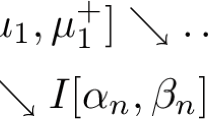Abstract
A description is given of then-generated free algebras in the variety of modular ortholattices generated by an ortholatticeMO 2 of height 2 with 4 atoms. In the subvariety lattice of orthomodular lattices, the varietyV(MO 2) is the unique cover of the variety of Boolean algebras, in whichn-generated free algebras were described by G. Boole in 1854. It is shown that then-generated free algebra in the varietyV(MO 2) is a product of then-generated free Boolean algebra2 2 n and Φ(n) copies of the generatorMO 2, and formula is presented for Φ(n). To achieve this result, algebraic methods of the theory of orthomodular lattices are combined with recently developed methods of natural duality theory for varieties of algebras.
Similar content being viewed by others
References
Beran, L. (1984).Orthomodular lattices. Algebraic Approach, Academia, Prague.
Birkhoff, G., and von Neumann, J. (1936). The logic of quantum mechanics,Annals of Mathematics,37, 823–843 [InJ. von Neumann Collected Works, Pergamon Press, Oxford (1961), Vol. IV, pp. 105–125].
Bruns, G. (1976). Free ortholattices.Canadian Journal of Mathematics,28, 977–985.
Burris, S., and Sankappanavar, H. P. (1981).A Course in Universal Algebra, Springer-Verlag, Berlin.
Clark, D. M., and Davey, B. A. (1998).Natural Dualities for the Working Algebraist, Cambridge University Press, Cambridge.
Davey, B. A., (1993). Duality theory on ten dollars a day, inAlgebras and Orders, I. G. Rosenberg and G. Sabidussi, eds, Kluwer Dordrecht, pp. 71–111.
Davey, B. A., and Werner, H. (1983). Dualities and equivalences for varieties of algebras, inContributions to Lattice Theory (Szeged, 1980), A. P. Huhn and E. T. Schmidt, eds, North-Holland, Amsterdam, pp. 101–275.
Davey, B. A., Haviar, M., and Priestley, H. A. (1995a). Endoprimal distributive lattices are endodualisable.Algebra Universalis,34, 444–453.
Davey, B. A., Haviar, M., and Priestley, H. A. (1995b). The syntax and semantics of entailment in duality theory.Journal of Symbolic Logic,60, 1087–1114.
Grätzer, G. (1978).General Lattice Theory, Birkhäuser-Verlag, Basel.
Husimi, K. (1937). Studies on the foundations of the quantum mechanics.Proceedings of the Physico-Mathematical Society of Japan,19, 766–789.
Kalmbach, G. (1983).Orthomodular Lattices, Academic Press, London.
MacLaren, M. D. (1964). Atomic orthocomplemented lattices.Pacific Journal of Mathematics,14, 597–612.
Pontryagin, L. S. (1966).Topological Groups, Gordon and Breach, New York.
Priestley, H. A. (1970). Representations of distributive lattices by means of ordered Stone spaces,Bulletin of the London Mathematical Society,2, 186–190.
Priestley, H. A. (1972). Ordered topological spaces and the representation of distributive lattices,Proceedings of the London Mathematical Society (3),24, 507–530.
Priestley, H. A., and Ward, M. P. (1994). A multipurpose backtracking algorithm,Journal of Symbolic Computing,18, 1–40.
Stone, M. H. (1936). The theory of representations for Boolean algebras, Transactions of theAmerican Mathematical Society,4, 37–111.
Wegener, C. B. (n.d.). Thesis, University of Oxford, in preparation.
Author information
Authors and Affiliations
Rights and permissions
About this article
Cite this article
Haviar, M., Konôpka, P., Priestley, H.A. et al. Finitely generated free modular ortholattices. I. Int J Theor Phys 36, 2639–2660 (1997). https://doi.org/10.1007/BF02435704
Received:
Issue Date:
DOI: https://doi.org/10.1007/BF02435704




